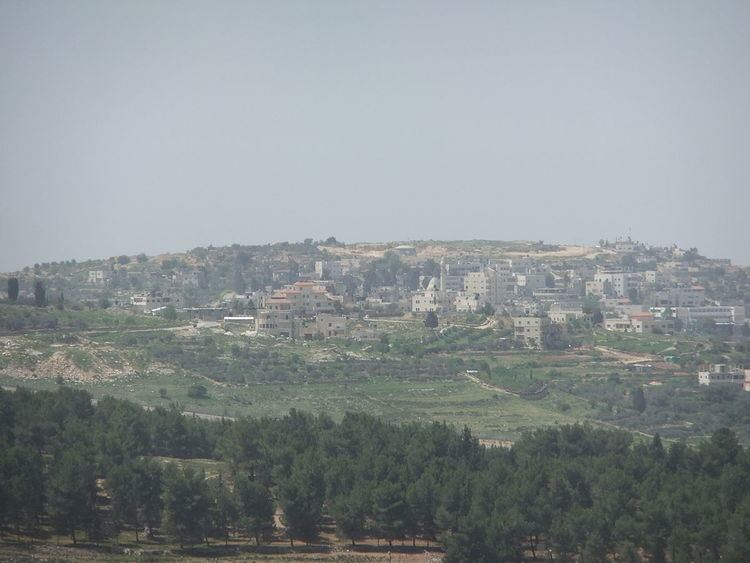Name meaning "Biddu", personal name | ||
 | ||
Weather 15°C, Wind SE at 10 km/h, 60% Humidity | ||
Biddu (Arabic: بدّو) is a Palestinian town in the Jerusalem Governorate, located 6 kilometers Northeast of Jerusalem in the northern West Bank. According to the Palestinian Central Bureau of Statistics, the town had a population of 6,368 in 2006. Biddu is at an altitude of 806m to 834m. Giv'on HaHadashah lies 2 km east of Biddu.
Contents
Map of Bidu
History
Bagatti suggested that several buildings in the town are from the 12th century. South-west of the centre is the ruined wali of Sheikh Abu Talal, which might have been a Crusader church.
Ottoman era
In 1838, during the Ottoman period, the American biblical scholar Edward Robinson noted the village during his travels in the area.
In May 1863 the French explorer Victor Guérin visited the village, called Biddou. He described it as being situated on a very high plateau, with some 150 inhabitants. Some houses seemed very old. In 1883 the Palestine Exploration Fund's Survey of Western Palestine described it as "a village on a rocky hill, with a well to the north east. It is of moderate size."
British Mandate era
In the 1922 census of Palestine conducted by the British Mandate authorities, Biddu had a population 252, all Muslims. This had increased in the 1931 census to 399, still all Muslim, in 88 houses.
In 1945 the population of Biddu consisted of 520 Muslims and the land area was 5,392 dunams, according to an official land and population survey. Of this, 334 dunams were designated for plantations and irrigable land, 2,258 for cereals, while 19 dunams were built-up areas.
1948-1967
On the night of 19 April 1948 the village was attacked by the Palmach. The attacking force was commanded by Yosef Tabenkin, based in Jerusalem. They were later to become the Harel Brigade of the Israeli army. The attack came from Beit Surik which had been captured earlier that night. Biddu was subjected to a short bombardment from a Davidka after which Palmach sappers entered the village and demolished its houses.
In the wake of the 1948 Arab–Israeli War, and after the 1949 Armistice Agreements, Biddu came under Jordanian rule.
1967-present
After the Six-Day War in 1967, Biddu has been under Israeli occupation.
Enclave
Biddu along with 9 other Palestinian villages, Beit Duqqu, Beit 'Anan, Beit Surik, Qatanna, al-Qubeiba, Beit Ijza, Kharayib Umm al Lahimand and at Tira form the "Biddu enclave" which, according to Tanya Reinhart, are imprisoned behind a wall, cut off from their orchards and farmlands that are being seized in order to form the real estate reserves of the Jerusalem Corridor and to create a territorial continuity with Giv'at Ze'ev. The enclave will be linked to Ramallah by underpasses and a road that is fenced on both sides. From the "Biddu enclave" Palestinians will travel along a fenced road that passes under a bypass road to Bir Nabala enclave, then on a second underpass under Bypass Road 443 to Ramallah.
Biddu, which has a record of peaceful coexistence with Jewish settlements, despite some violent confrontations, has become a focal point for non-violent resistance to the process of incorporating Palestinian lands into Israeli settlements. Biddu villagers promote the use of their bodies to hinder bulldozing of their terrain, and recourse to arms or violence is forbidden.
Attempts to have "women only" protests, to avoid conflict, have met with defeat. In one demonstration by Israeli and local women activists in April 2004,a protest by 70 women brandishing signs and singing was broken up by tear gas, stun grenades, and mounted police. Diaa' A-Din 'Abd al-Karim Ibrahim Abu 'Eid was shot dead by gunfire during an anti-barrier demonstration on 18 April 2004. Muhammad Fadel Hashem Rian and Zakaria Mahmoud 'Eid Salem were shot dead during anti-barrier demonstrations on 26 February 2004 at Beit Ijaz (a satellite village of Biddu).
